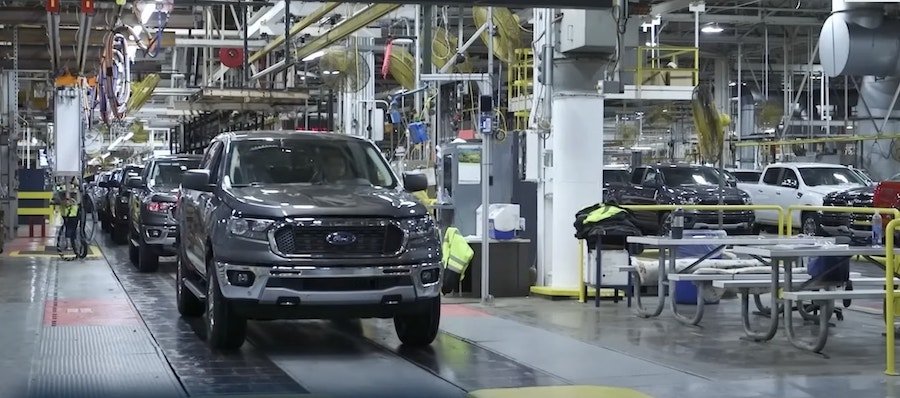Inside the Ford Plant That Builds the Ranger: The Truck Goes Through a Simulated Storm

One Ford Ranger rolls off the production line every two minutes at the Silverton Assembly Plant in South Africa and at the Ford Thailand Manufacturing in Thailand. According to Ford's CEO Jim Farley, a Blue Oval pickup truck rolls off the production line every 33 seconds worldwide. Almost 600 robots assist the human workers on the chassis line. Each chassis takes around three hours to build.
Overhead conveyors are used extensively along the assembly line. They help workers install components under the vehicle. Several tools are used to aid them during the assembly phase. For instance, pneumatic manipulators move the vehicle doors around, put them in place, and tighten the attaching bolts with electronic wrenches.
Before being attached to the mid-size pickup truck, the door subassembly receives all the electronic components and the window system. The dashboard is installed inside the Ranger with the assistance of arm manipulators, which position it in place. Afterward, with the help of electric wrenches, workers attach every part of the structure.
The body components, including the cabin and the bed tray, are placed over the frame in a process called "marriage." The factory workers tighten the brake system as the vehicle moves through the conveyor.
The body of every single Ranger contains around 3,000 - 4,000 spot welds and more than 2,700 parts. Once the body is built, the vehicle is sent to the painting process, where the primer and paint coating are applied. The plant uses approximately three liters of primer, three liters of base coat, and two liters of clear coat in what Ford calls the "3-Wet High Solid Paint," for each vehicle.
The painting process is followed by the paint scanner test. The scanner can detect defects as small as 0.2 square millimeters. That is smaller than a needlepoint.
Ford started the production of the next-generation Ranger's chassis at its new plant, Silverton, in South Africa, in 2022. To build the vehicle structure, the factory uses press machines to form the metal parts of the body.
The Ranger sits on the T6 platform, designed by Ford Australia, and is built on a body-on-frame structure, which means that the chassis carries the engine and drivetrain, while the suspension, brakes, and steering are also mounted onto it.
A forming limit diagram, which determines high-stress areas, is used to predict the behavior of the material during sheet metal forming. An automative metal sheet, also known as a 20-gauge steel sheet metal has an average thickness of 0.0359 inches in the latest automobiles.
During the stamping process, the sheet metal is placed over the die, which will create the necessary shape. The punch presses over the sheet to make the part. A typical pressing line exerts a pressing force of 8,100 tons. For complex shapes, the process often includes multiple stages, known as draws. High-strength steel is the main material used by Ford for its Ranger.
By transferring the chassis manufacturing in-house at the Silverton plant, Ford can monitor and control the quality of the vehicle over every stage of the process. There are two identical production lines that operate in the Silverton plant, manufacturing steel frames with over 15 different frame derivatives.
An Atlas Copco multi-spindle nutrunner is used to bolt the 17- or 18-inch wheels into the vehicle, providing the correct torque distribution.
There are several engine choices in the Ranger lineup. The entry-level version is powered by the 2.3-liter EcoBoost V6 twin-turbocharged petrol engine. Upper in the range, there is the 2.7-liter EcoBoost engine, with either front-wheel or all-wheel drive, and the 3.0-liter EcoBoost with four-wheel drive. All engines are mated to a ten-speed auto box.
There are more than 380 trained employees, whose job is to make sure the automated systems throughout the plant operate properly. Once the manufacturing process is completed, all Rangers go into the light tunnel for quality inspection.
Each vehicle undergoes nearly 1,000 quality confirmation checks before it hits the dealership. Furthermore, technicians perform 300 electronic diagnostics checks and 35 electrical current-based tests.
The procedures also include the Water Test. This involves spraying every Ford Ranger with water for 20 minutes to replicate the worst storm imaginable. Once the water jets are turned off, the vehicle will be visually inspected to make sure that no water breached the seals and everything in the cabin and load bed is dry.
The vehicles also go through the performance tests, where the handling and drive characteristics are examined by specialists before they are loaded to a trailer and shipped to showrooms.
The Ford Ranger for the US market has been completely redesigned for the 2024 model year based on the global product. FoMoCo unveiled the pickup truck with F-150 styling on May 10, 2023. The model is set to hit the market later this year with F-150 styling. The footage from the factory shows the previous-gen Ranger.
Related News
